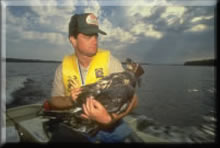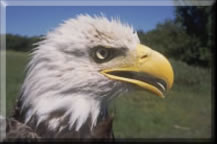|

 Complete Listing Complete Listing

|
|
Bald Eagles Thrive in the Kansas City District
 |
| Mike Watkins, Kansas City District, conducting eagle research. | | |
 |
Partners: USACE;
US Fish & Wildlife Service; Iowa Division of Fish & Wildlife; Kansas Dept. of Wildlife & Parks; Missouri Deptartment of Conservation; Nebraska Game & Parks Commission
Corps POC: Michael Watkins, Wildlife Biologist, Corps Kansas City District
Story: For over 30 years, Corps lakes have provided critical habitat for hundreds of wintering birds in portions of Iowa, Kansas, Missouri, and Nebraska. Last winter, 138 bald eagles were counted during an aerial survey at Smithville Lake in Missouri, and it wasn't uncommon to view 70 to 80 eagles at Milford Lake, Kansas during a typical December or January afternoon. Over the past 13 years, some 215 juvenile eagles have been hatched and fledged from more than 30 nesting territories. Each nesting territory can present a unique set of management challenges. When a new nest site is discovered, representatives from the Corps, the U.S. Fish & Wildlife Service, and the appropriate state wildlife management agency meet to develop a management plan to protect the nest site. Management activities can vary greatly depending on the location of the nest and how many visitors use the area. At Truman Reservoir, for example, many of the nests are located in relatively remote areas and nothing other than routine monitoring is required. At Clinton Lake, however, restricted zones are established around the nest trees to keep the recreating public from disturbing the nesting birds. This pioneering bald eagle effort has been a tremendous success story for the Corps and the nation. It is proof that integrating flood control, municipal water supply, and high quality recreation for large numbers of people, while at the same time providing critical habitat for a federally listed species, is an achievable goal.
What our partners are saying: "We expect the bald eagle population in Kansas and throughout the Midwest to continue to expand. The increase in bald eagle numbers nationwide has resulted in the birds returning to regions of the country they apparently abandoned more than 100 years ago. They seem to be taking advantage of new habitat provided by the construction of large water impoundments. As a result, the new nesting populations are likely to concentrate around lakes and reservoirs rather than the traditional river and stream corridors." - Dan Mulhern, Endangered Species Biologist with the USFWS in Manhattan, KS.
|



